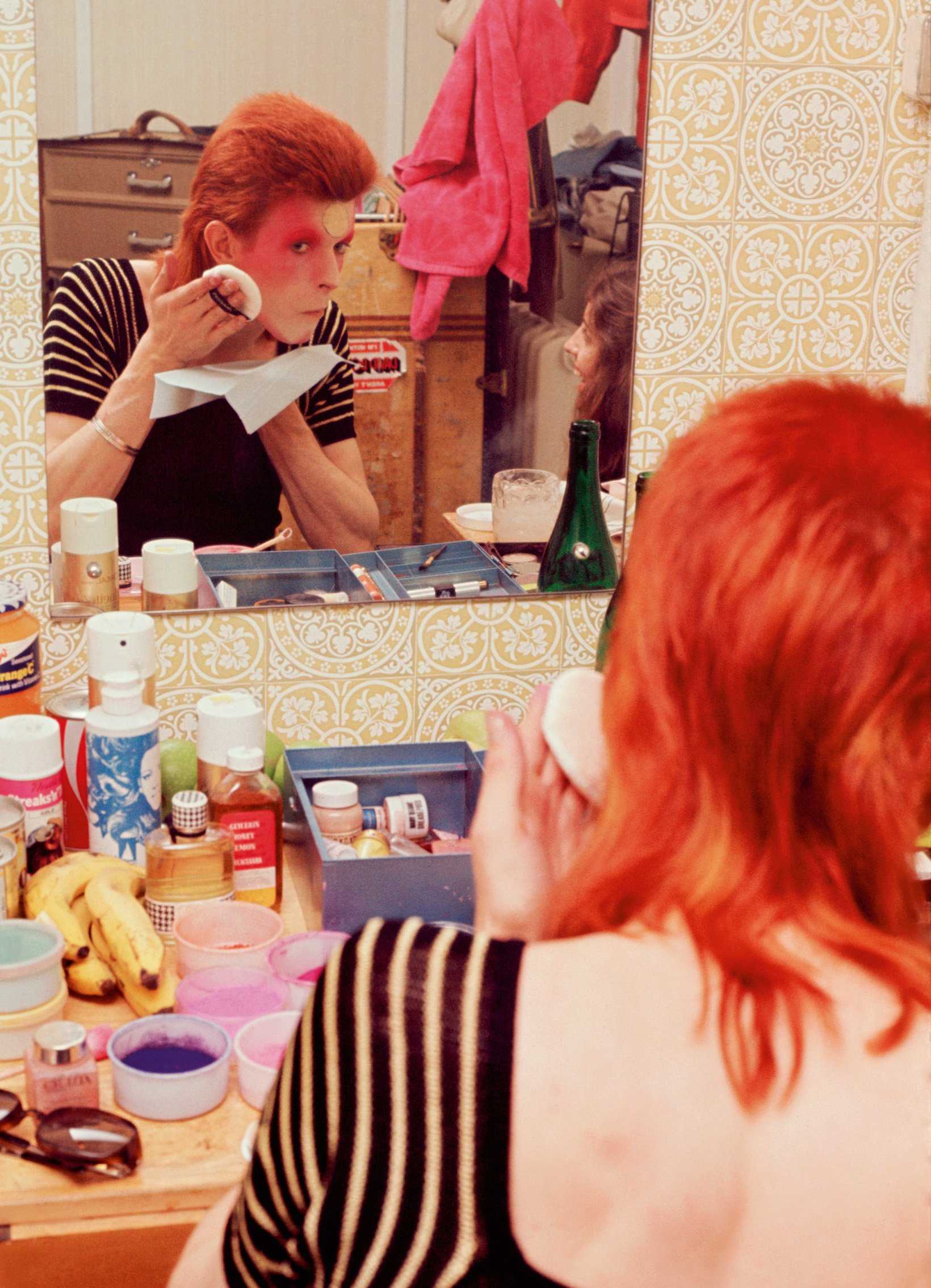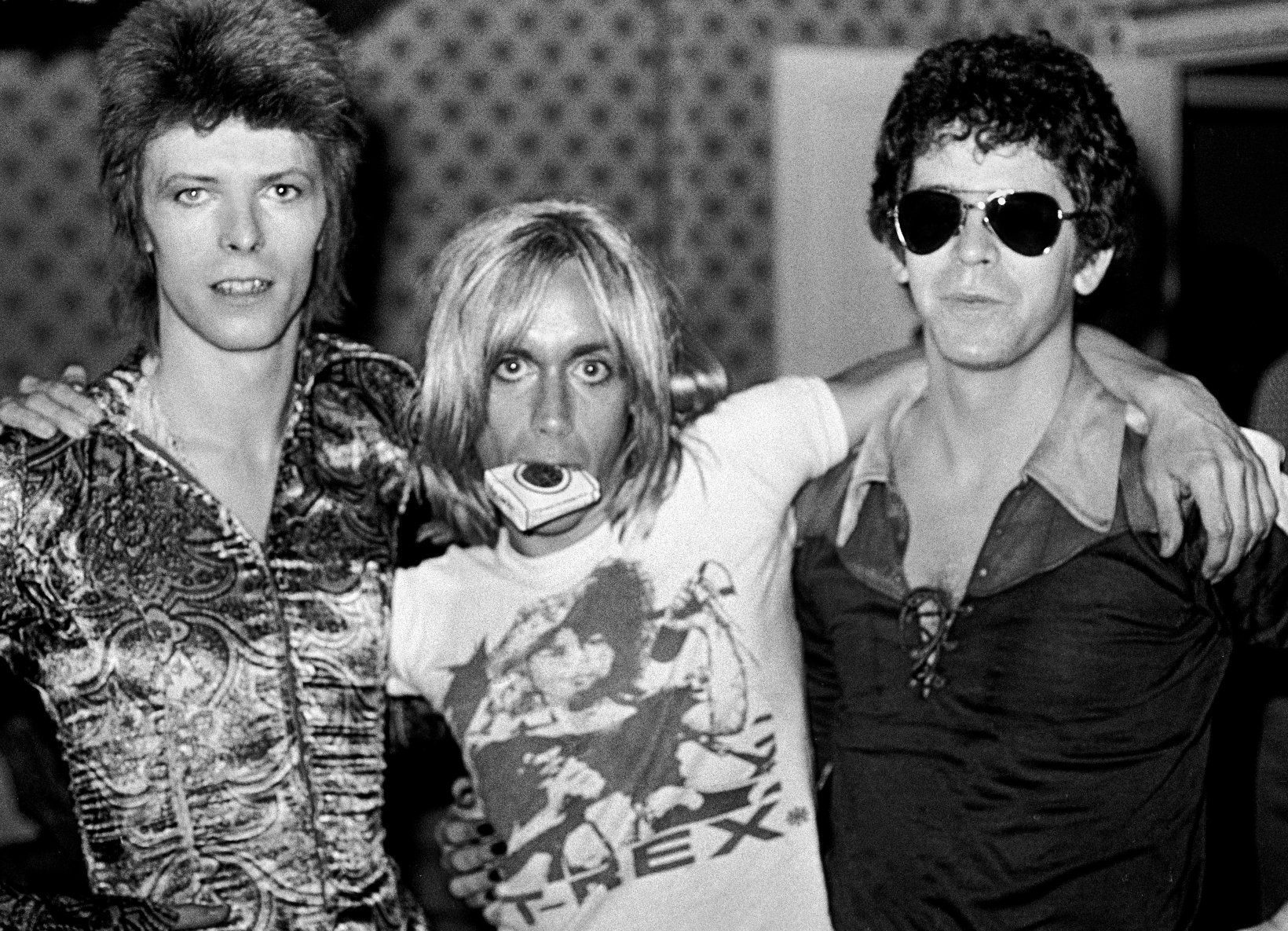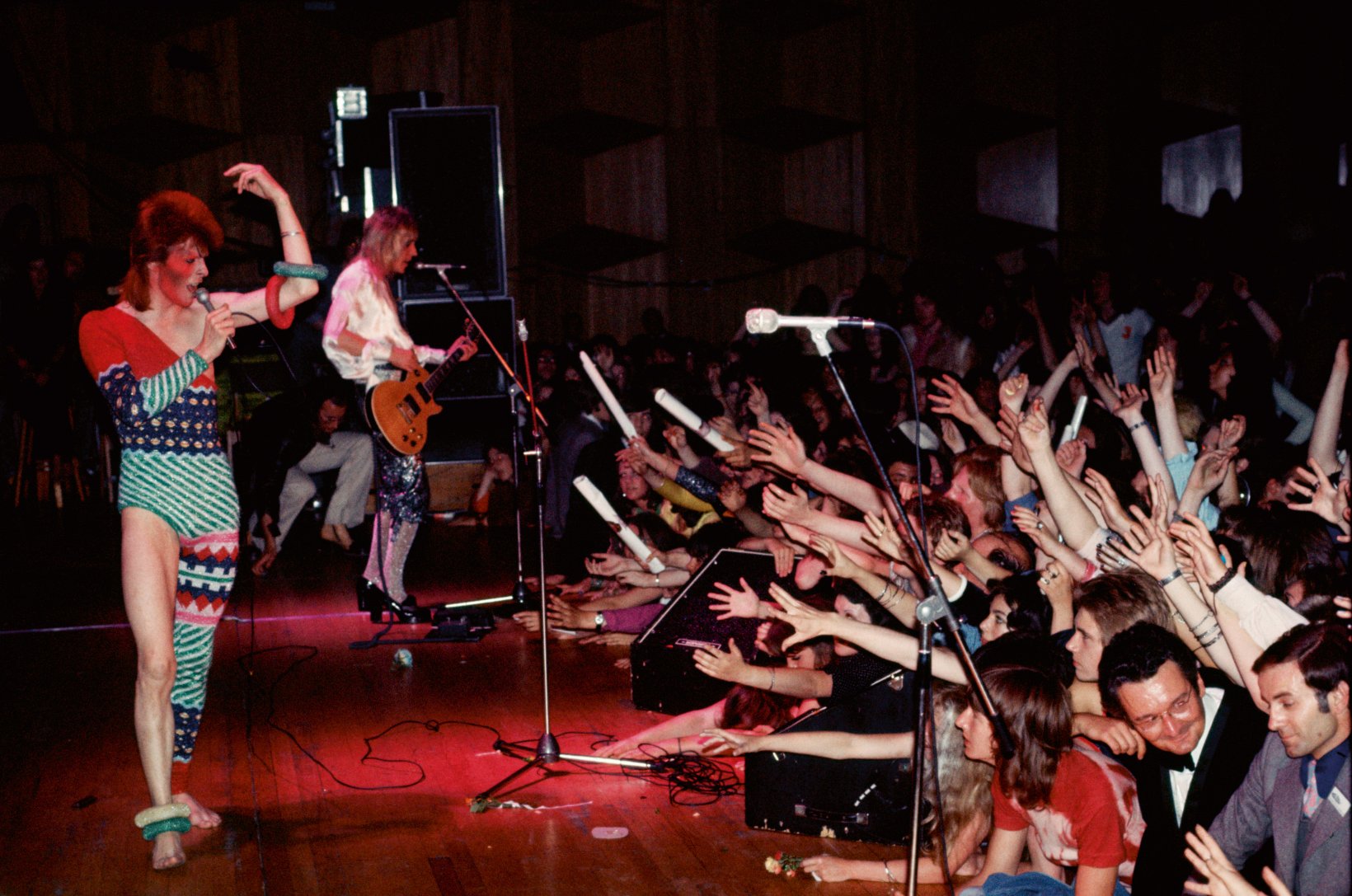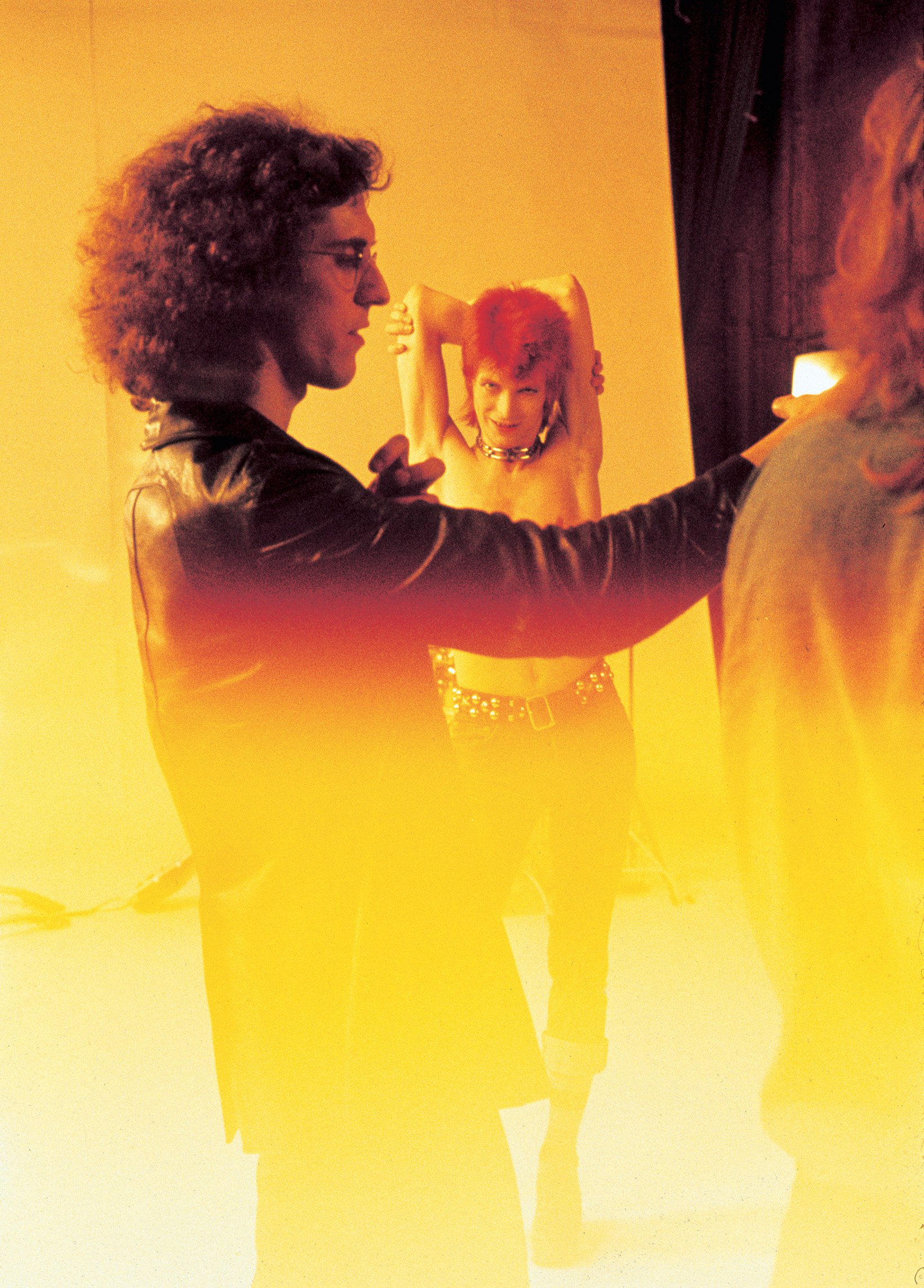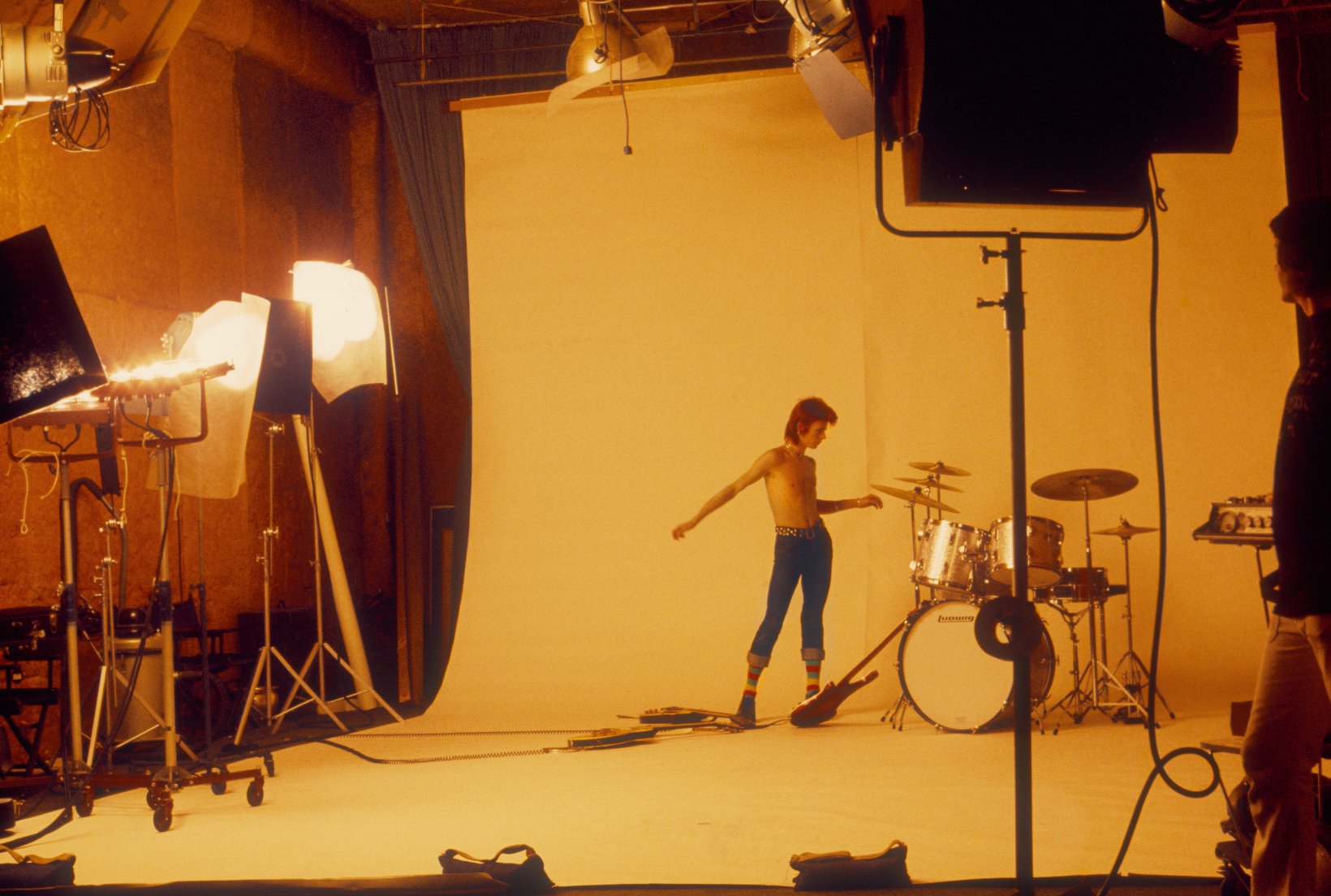

"UVEK JE POSTIZAO to što je hteo" napisao je rano tog jutra(11. januara 2016.) njegov dugogodisnji saradnik Toni Viskonti , nakon sto je smrt Dejvida Bouvija objavljena u zvanicnom saopstenju. "Njegova smrt nije se razlikovala od njegovog života - umetničkog dela." Bouvijev život i umetnost bili su duboko zaronjeni u beskrajni kreativni prostor na jedinstven i neponovljiv nacin,potpuno kompletiran i oslobodjen.Prateći stope Caravaggioa ,Van Gogha i Beethovena,bio je u lozi istinski nadahnutih umetničkih duša.Sa druge strane,bio je prvi od svoje vrste .Rock n roll začetnik ,kreator i inovator,mas medijski manipulator.Umetnik koji je u stanju da stvori nešto tako izuzetno duboko i lično,da je samo on mogao da dokuči puni smisao svega toga,a sa druge strane izuzetno pristupačan, izrodilo je prisustvo koje je postalo heroj i inspiracija miliona.On je bio najveci,najpristupačniji,najiintimniji,voljom i kreativnošću najeksperimentalniji muzički umetnik XX. i XXI veka i jedan od najvećih muzičkih stvaralaca koji su ikad hodali ovom planetom.
Početak glazbene karijere
David Robert Jones rođen je u Brixtonu (London), od oca Stentona Jonesa, koji dolazi iz Doncastera (Yorkshire) i majke Margaret Mary Jones, koja potječe iz irske obitelji. Bowievi roditelji se vjenčavaju nakon njegovog rođenja[3]. Žive u Brixtonu, Stansfield Road 40, do Bowieve šeste godine, kada se sele u Bromley (Kent). Bowie se školuje u "Bromley Technical High School"[4], koja se nalazi u Kestonu, u Bromleyu, gdje sa svojim roditeljima živi do svoje osamnaeste godine.
S petnaest godina Bowie je doživio nesreću kada ga je njegov prijatelj George Underwood, koji je nosio prsten na ruci, udario u lijevo oko radi jedne djevojke i teško ga povrijedio. Bowie je osam mjeseci izostao iz škole, sve dok doktori nisu završili s operacijama i dok opet nije mogao normalno otvarati i zatvarati oko. Bez obzira na sve teškoće koje je prošao, ostao je dobar prijatelj s Underwoodom, koji je kasnije ilustrirao Bowieve rane albume[5]. Doktori ipak nakon svega nisu uspjeli skroz zaliječiti njegovo oko, jer mu je zjenica neprestano dilatirala. Rezultat toga je njegovo trajno oštećenje dubinskog opažanja, kao i teško raspoznavanje boja.
Bowiev interes za glazbu počinje od njegove devete godine, kada pod utjecajem oca koji je sakupljao LP ploče, počinje slušati Fatsa Dominoa, Chucka Berryja i vrlo popularnog Little Richarda. Prilikom slušanja velikog Richardovog hita "Tutti Frutti" Bowie je znao govoriti: "Ovo mora čuti Bog". Njegov polubrat Terry uvodi ga u suvremeni jazz i Bowie se oduševljava Charlesom Mingusom i Johnom Coltraneom, dok od majke za Božić 1959. dobiva plastični saksofon.
Svoju glazbenu karijeru Bowie počinje vrlo rano, kao šesnaestogodišnjak. Godine 1962. osniva svoj prvi sastav koji se zvao "The Konrads". Tijekom 1960-ih godina član je mnogih blues sastava, a neki od njih su: The King Bees, The Manish Boys, The Lower Third i The Riot Squad. S King Beesima 1964. izdaje svoj prvi singl "Liza Jane". Kasnije sa bluesa prelazi na stil britanskog popa. Rani singlovi snimljeni u vremenu 1964.-1966. ostaju gotovo nezapaženi.
U ranim šezdesetima Bowie nastupa pod imenom "Davie Jones", pa su ga zamjenjivali s glumcem i pjevačem Davyjem Jonesom iz grupe "The Monkees". Zbog toga svoje umjetničko ime mjenja u "Bowie", po junaku Jimu Bowieu poznatom po Bowie nožu. U to vrijeme snima singl "The Manish Boys" za izdavačku kuću Parlophone kao Davy Jones, dok prelaskom u izdavačku kuću Pye izdaje pod imenom David Bowie.
Bowie svoj prvi album izdaje 1967. godine za izdavačku kuću "Decca Records" (koja je ogranak kuće "Deram"), pod jednostavnim imenom David Bowie. Album je mješavina popa i psihodelije. Približno u to vrijeme izdaje novi singl "The Laughing Gnome". Kasnije kuća "Deram" njegov rani materijal na albumima i singlovima obnavlja i zajedno ga stavlja na kompilaciju.
Psihodelični folk i glam rock[uredi VE | uredi]
David Bowie drastično mijenja svoj glazbeni stil i imidž, te u maniri hipi pokreta za diskografsku kuću "Mercury" izdaje album Man Of Words, Man Of Music. Album nije privukao veliku pažnju, ali se na njemu nalazi skladba "Space Oddity", koja ponovo izlazi kao singl i postiže zapaženi uspjeh u Velikoj Britaniji[6]. Reizdanje albuma izlazi 1972. pod imenom Space Oddity.
U vrijeme kada završava skladbu "Space Oddity", počinje živjeti s Mary Finnigan kao podstanar. Finnigan i Bowie, zajedno s Christinom Ostrom i Barriejem Jacksonom, subotom navečer nastupaju u folk klubu "The Three Tuns pub" koji se nalazi u Beckenhamu (London)[7]. The Arts Lab bio je domaćin "Free Festivala" koji je održan u lokalnom parku, a to je kasnije Bowie uglazbio u svom singlu "Memory of a Free Festival"[8].
Zajednička glazbena suradnja s Marcom Bolanom (pjevač, tekstopisac), Mickom Ronsonom (gitara), Johnom Cambridgeom (bubnjevi) te Johnom Viscontijem (bas gitara, producent) koji nastupaju pod imenom "Hype" bili su temelji stalnoga pratećeg sastava, u koji je kasnije došao bubnjar Michael "Woody" Woodmansey. Bowie s ovom postavom 1970. godine izdaje svoj treći album The Man Who Sold the World, na kojem odbacuje zvuk akustične gitare s prijašnjih albuma i zamjenjuje ga zvukom električne gitare Micka Ronsona. Premda je ovo bio "prvi pravi" Bowijev album, sa svojim hard rock stilom i praskavim Ronsonovim gitarskim izvedbama nije zabilježio veći uspjeh.
Njegov sljedeći album bio je Hunky Dory (objavljen 1971. godine), koji također nije bolje prošao od prethodnoga, mada su kasnije glazbeni kritičari isticali kako je to jedan od ključnih Bowievih albuma. Nakon izdavanja albuma Bowie skandalozno najavljuje svojuhomoseksualnost, te boji kosu crveno i izgleda kao androgina rock zvijezda. Bio je to uvod za album The Rise and Fall of Ziggy Stardust and the Spiders from Mars, jedan od ključnih trenutaka, kako u Bowievoj diskografiji, tako i u povijesti rocka. Na albumu se nalazilo nekoliko skladbi koje su bile povezane svojom pričom, a ostale su bile pod dojmom sage o rock zvijezdi i stardomu općenito. Na Ziggyjuse vidi srastanje svih dotadašnjih Bowievih fascinacija; psihodelije šezdesetih, raskošnih melodija, kabaretskih aranžmana, pop produkcije, praskavih riffova na gitari, puhačkih izvedaba i još mnogo drugog[9]. Bowie na albumu kombinira hard rock s albuma The Man Who Sold the World s veselijim eksperimentalnim rockom s albuma Hunky Dory i glam rockom (od njegova pionira Marca Bolana iz T. Rexa). Mnogo pjesama s albuma postali su rock klasici: "Ziggy Stardust", "Moonage Daydream", "Hang on to Yourself" i "Suffragette City."
U to vrijeme Bowie se ubrzo promaknuo u veliku rock zvijezdu i počeo je jako puno raditi u glazbi. Osnivač i pjevač sastava "Velvet Underground", Lou Reed, u svom solo probijanju angažira Bowiea da mu, zajedno s Mickom Ronsonom, bude producent na njegovom drugom albumu Transformer. Iggy Pop sa svojim sastavom "The Stooges" potpisuje s Bowiem poslovnu suradnju oko produkcije njihovog trećeg albuma Raw Power. To nije bilo primjetno originalnim skladbama s albuma, već Bowie kasnije radi velike promjene u miksanju. Bowie surađuje i na povratničkom albumu "Moot The Hooplea" All The Young Dudes, a uza sve to objavljuje i svoj novi materijal Aladdin Sane, koji izlazi u travnju 1973.
Aladdin Sane slijedi prethodni stil glam i hard rocka i Bowie prvi puta s njim dolazi na broj 1 britanske top liste. Hit skladba "The Jean Genie" dospjela je na broj 2 ljestvice singlova, a "Drive-In Saturday" na broj 3. Album uključuje i obradu pjesme The Rolling Stonesa, "Let's Spend the Night Together". Bowie angažira Mikea Garsona da mu svira klavir na albumu i solo u naslovnoj skladbi, što je istaknuto kao najbitniji uradak na materijalu[10].
1. I'm Not Losing Sleep *
2. I Dig Everything *3. Can't Help Thinking About Me
4. Do Anithing You Say
5. Good Morning Girl
6. And I Say To Myself
Born David Jones in Brixton on January 8, 1947, the youngster was perfectly placed to feed off the two most progressive forces of 20th Century music – rock’n’roll and jazz – and he did not look back.
Initially inspired by early Elvis Presley and Little Richard 45s his father brought home, he experimented with skiffle before his step-brother introduced him to the music being created by John Coltrane and his contemporaries, which in turn led the young Jones to the saxophone.In the ’60s, he settled on rock’n’roll, though his initial attempts to break onto the London scene proved frustrating at first – as did the confusion between his own name and that of The Monkees’ Davy Jones – and David Bowie’s (the surname adopted from 19th-century American frontiersman Jim Bowie) self-titled 1967 debut album was something of a non-event.
With success and a new record deal eluding him, Bowie was not to follow up with another release for two years, but he did not waste his time. Instead, his thoughts turned towards image and presentation in a serious and ultimately original way.

God Bless David Bowie, May He Rest In Peace.
*Time Stamps are estimates and are not tested in accordance with the video*
1-01 Uncle Arthur 0:00:00
1-02 Sell Me a Coat 0:02:12
1-03 Rubber Band 0:05:14
1-04 Love You Till Tuesday 0:07:34
1-05 There is a Happy Land 0:10:48
1-06 We Are Hungry Men 0:14:04
1-07 When I Live My Dream 0:17:04
1-08 Little Bombardier 0:20:30
1-09 Silly Boy Blue 0:23:57
1-10 Come and Buy My Toys 0:27:51
1-11 Join the Gang 0:30:01
1-12 She's Got Medals 0:32:21
1-13 Maid of Bond Street 0:34:47
1-14 Please Mr. Gravedigger 0:36:32
2-01 Rubber Band (Mono Single A-Side) 0:39:12
2-02 The London Boys (Mono Single B-Side) 0:41:16
2-03 The Laughing Gnome (Mono Single A-Side) 0:44:38
2-04 The Gospel According to Tony Day (Mono Single B-Side) 0:47:36
2-05 Love You Till Tuesday (Mono Single A-Side) 0:50:24
2-06 Did You Ever Have a Dream (Mono Single B-Side) 0:53:25
2-07 When I Live My Dream (Mono Single Master) 0:55:33
2-08 Let Me Sleep Beside You (Mono Single Master) 0:59:25
2-09 Karma Man (Mono Decca Master) 1:02:52
2-10 London Bye Ta-Ta (Mono Decca Master) 1:05:57
2-11 In the Heat of the Morning (Mono Decca Master) 1:08:35
2-12 The Laughing Gnome (New Stereo Mix) 1:11:22
2-13 The Gospel According to Tony Day (New Stereo Mix) 1:14:21
2-14 Did You Ever Have a Dream (New Stereo Mix) 1:17:12
2-15 Let Me Sleep Beside You (Stereo Single Version) 1:19:21
2-16 Karma Man (New Stereo Version) 1:22:42
2-17 In the Heat of the Morning (Stereo Mix) 1:25:47
2-18 When I'm Five 1:28:47
2-19 Ching-a-Ling (Full Length Stereo Mix) 1:31:55
2-20 Sell Me a Coat (1969 Version) 1:34:47
2-21 Love You Till Tuesday (BBC Version) 1:37:44
2-22 When I Live My Dream (BBC Version) 1:40:43
2-23 Little Bombardier (BBC Version) 1:44:18
2-24 Silly Boy Blue (BBC Version) 1:47:46
2-25 In the Heat of the Morning (BBC Version) 1:51:10

Despite Space Oddity, a still-extraordinary UK Number 1 single brilliantly timed for the July 1969 moon landing, a second attempt at a self-titled album (re-released in 1972 as Space Oddity) also failed to launch Bowie commercially. But the scope, individuality and artistry found in its grooves pointed somewhere new. Subsequent albums – The Man Who Sold The World (produced by Tony Visconti) and Hunky Dory (abetted by Ken Scott) – built on its merits, mixing rock and folk, Burroughs and Broadway. Bowie was touching greatness and he knew it.
But it took an alien presence secure worldly stardom: Ziggy Stardust. Touring as the live manifestation of the central character of his 1972 quasi-concept album, The Rise And Fall Of Ziggy Stardust And The Spiders From Mars, Bowie cemented and then transcended cult fandom, providing the spark for the glam rock boom. Producing Lou Reed’s solo album Transformer with Spiders guitarist Mick Ronson, and providing All The Young Dudes for Mott The Hoople’s hit the same year, Bowie was on fire, but with the subsequent Aladdin Sane, Pin Ups and Diamond Dogs straining increasingly at glam’s leash the main man was not going to stay in one place for long.
Instead 1975’s Young Americans heralded the first of many successful sea changes for Bowie, as he couched his own ideas in the warm textures of funk and soul. A year later, the relentlessly intense Station To Station saw Bowie communing with another extraterrestrial explorer, becoming the Thin White Duke of the album’s title track, a version of Thomas Jerome Newton, the character the singer played in Nicolas Roeg’s film The Man Who Fell To Earth which was released the same year.
But increasing drug use and psychic dislocation – witnessed in the contemporary BBC documentary Cracked Actor – made it clear that more than just a musical change was needed. Bowie moved to Geneva before taking up residency in West Berlin, where he found respite from his addictions and a new lease of creativity inspired by the divided city’s fertile artistic scene.
His own Berlin triptych – Low (1977), “Heroes” (1977) and Lodger (1979) – created in collaboration with Visconti and Brian Eno, would have been vindication enough, as he incorporated a head-spinning array of new, local influences (Kraftwerk, Neu!) and Cold War-infused ideas. Yet in the same period he also revitalised Iggy Pop, helping to create his first pair of solo albums, The Idiot and Lust For Life.
This is a self-compiled collection of what I believe are the best Bowie songs from this era.
Tracklisting:
01. Space Oddity - 0:00
02. The Prettiest Star - 5:16
03. The Man Who Sold The World - 8:27
04. Changes - 12:26
05. Oh! You Pretty Things - 16:03
06. Life On Mars? - 19:15
07. Queen Bitch - 23:09
08. Five Years - 26:28
09. Moonage Daydream - 31:11
10. Starman - 35:51
11. Lady Stardust - 40:05
12. Hang On To Yourself - 43:26
13. Ziggy Stardust - 46:04
14. Suffragette City - 49:18
15. Rock 'n' Roll Suicide - 52:43
16. John, I'm Only Dancing - 55:44
17. Velvet Goldmine - 58:33
18. The Jean Genie - 1:01:46
19. All The Young Dudes - 1:05:53
20. Aladdin Sane (1913-1938-197?) - 1:10:06
MICK ROCK’S LUSCIOUS TASCHEN tome, The Rise Of David Bowie, 1972-1973, is a stunning tsunami of some of the 5,000-plus images the photographer snapped over Bowie’s iconic and career-making Ziggy Stardust period.
Purchasers of MOJO magazine’s latest Bowie-themed edition will already be enjoying a special print of one of the previously unpublished images from one of Rock’s earliest Bowie shoots. And anyone with a superfan in their life and a Christmas present hole to fill might wish to explore its source, a labour of love for the photographer.

“Bowie hypnotised me,” Rock tells MOJO. “Maybe it was partly the LSD and partly the yoga I’d started doing. But I had my brain wide open. And there was a little vibe of my friend Syd Barrett in there, too. When we started to talk he was very intrigued by Syd.”
What was it like rolling with Bowie in 1972? “Inspiring,” says Rock. “I saw him as a ringmaster, like the Energiser bunny.” Certainly, the singer’s charisma and creative power was at a phenomenal peak…
“David was dabbling in Buddhism,” says Rock. “There are a couple signs of it on Hunky Dory. And he was into some kind of Buddhist projection. He was in a state of total yesness. He tapped into some magic.”
Limited to a total of 1,972 numbered copies signed by David Bowie and Mick Rock,The Rise Of David Bowie is available as Collector’s Edition (No. 201-1,972), and also in two Art Editions of 100 copies each, with a pigment print signed by Rock. Each boasts a striking five-way lenticular cover, whose images appear to follow you around the room.
Rock is particularly pleased with how the cover turned out: “It swings any way you want it to, darling, ha ha!”
Classic album from 1970.
Faixas/Tracks:
01 - The Width of a Circle 0:00
02 - All the Madmen 8:05
03 - Black Country Rock 13:44
04 - After All 17:20
05 - Running Gun Blues 21:15
06 - Saviour Machine 24:32
07 - She Shook Me Cold 29:00
08 - The Man Who Sold the World 33:15
09 - The Supermen 37:13
Faixas/Tracks:
01 - Changes 0:00
02 - Oh! You Pretty Things 3:34
03 - Eight Line Poem 6:47
04 - Life On Mars 9:42
05 - Kooks 13:34
06 - Quicksand 16:29
07 - Fill Your Heart 21:37
08 - Andy Warhol 24:44
09 - Song for Bob Dylan 28:39
10 - Queen Bitch 32:51
11 - The Bewlay Brothers 36:13

Space Oddity 0:00
Unwashed and Somewhat Slightly Dazed 5:16
(Don't Sit Down) 11:32
Letter to Hermione 12:11
Cygnet Committee 14:48
Janine 24:24
An Occasional Dream 27:50
Wild Eyed Boy From Freecloud 30:51
God Knows I'm Good 35:42
Memory of a Free Festival 39:05
I.I.I. : How aware of David Bowie were you?
“By the end of it, he almostbecame Ziggy. Became trapped in the character.”MICK ROCK
And what do you remember of your first meeting?
He was instantly charming and he had a very “up” vibe about him, as he always did in those years. I felt that positive force in him from the beginning. Compare him with Lou Reed – who David actually introduced me to – and that was a much murkier, you could say subterranean vibe.
The first thing David said to me was, I like your name. Of course the joke being that my name is actually my name, whereas David Bowie… well he had to distinguish himself from Davey Jones from the Monkees, didn’t he? But Bowie’s such a great name…
There are so many pictures, the book can’t help but project a theme of transformation. You can see him incrementally inhabit the Ziggy character…
Yes well, for that 20 month period I have about 5,500 pictures and I’ve counted 74 different outfits. Some of them he only wore once – like the one he wore in the Life On Mars? video. By the end of it, he almost became Ziggy. Almost became trapped in the character.
The volume of creative decisions is stunning…
He was moving very fast. And he was always sucking up information. That was another amazing thing. You’d say something to him once and he’d catch on and process it into his mischief. It was a magical moment, especially that summer of ’72. Starman, then All The Young Dudes for Mott The Hoople, then the album. David was just rising. That gig at Oxford Town Hall [site of Rock’s famous guitar-fellatio shot – June 72], I think that was his biggest show to that point, maybe a thousand people there. I think that was his first time in four figures. After that it was… romper room!
Do you think being a writer as well helped you sniff out the story, perceive the narrative?
I do – because I wasn’t just running in taking some pictures and running off. I was spending time with him. I did an interview with him for Rolling Stone, and another for Club International, who were trying to do what Playboy had done, with the cultural section before you got to the boobies and bottoms. That was where that picture of him in the mirror first showed up.
There’s lots of candid stuff in the book. He didn’t mind you seeing him put the mask on…
I love how mundane the surroundings are. He’s in the wild, one-legged Kansai outfit but he’s in this grotty dressing room having a fag. Or drinking something out of a paper cup. This exotic creature! Then again, I wasn’t very interested in being a realist. I was interested in what he was projecting. That’s what excited me. That’s what I photographed.
There’s also a sensuality. Some of these shots are like a ballerina getting ready…
He was very connected to his body. His apprenticeship with Lindsay Kemp gave him a lot of confidence in that regard. How many rock stars had studied mime? He was influenced by so many things: including The Living Theatre, including Jacques Brel, including the Velvet Underground; including Iggy – Iggy is Ziggy; Marcel Marceau; Stanley Kubrick. He shared a birthday with Elvis Presley, too.
He was brave – committed to the look, the attitude…
He had a lot of balls. It was an entirely different universe, then. The broad public were quite antagonistic towards what he was doing. This was 42, 43 years ago, but what he was doing then is still ahead of the game – notwithstanding Lady Gaga and all these characters.
Did you ever think, this isn’t going to work?
Not really. One thing he said to me early on: ‘Mick, I’m so focused on this.’ You gotta remember how unhip it was to talk about being a star. This was 1972, the vestiges of hippy: tune in, turn on, who gives a f**k…
But he did give a f**k. He was focused on the quest for… for fame and glory. He said, ‘If you came to me and told me that my best friend had just died, I’d probably go, Oh, what a shame, that’s terrible… then I’d go straight back to work.’ Now, obviously, his best friend *hadn’t just died and he was talking theoretically, but that illustrates his frame of mind. No, I never saw any wavering. When he made Ziggy Stardust he wasn’t a star, but it was all about projecting stardom. He wanted it. Huge.In 1972, David Bowie released his groundbreaking album The Rise and Fall of Ziggy Stardust and the Spiders from Mars. With it landed Bowie’s Stardust alter-ego: A glitter-clad, mascara-eyed, sexually-ambiguous persona who kicked down the boundaries between male and female, straight and gay, fact and fiction into one shifting and sparkling phenomenon of ’70s self-expression.
Together, Ziggy the album and Ziggy the stage spectacular propelled the softly spoken Londoner into one of the world’s biggest stars. A key passenger on this glam trip into the stratosphere was fellow Londoner and photographer Mick Rock. Rock bonded with Bowie artistically and personally, immersed himself in the singer’s inner circle, and, between 1972–1973, worked as Bowie’s official photographer.
This limited and numbered edition brings together the best of Rock’s Bowie portfolio with spectacular stage shots as well as intimate backstage portraits. Pictures for press, album jackets, and stills from promo movies sit alongside around 50 percent previously unseen images, offering unprecedented access to the many facets of Bowie’s personality and his fame. The book’s hologram cover, composed of different head-shots, rejoices in Bowie’s fearless experimentation and unpredictability.
Through the aloof and approachable, the playful and serious, the candid and the contrived, this is a tribute bursting with the daring and energy of a unique star and his eternal inspiration.
Limited to a total of 1,972 numbered copies signed by David Bowie and Mick Rock, this book is available as Collector’s Edition (No. 201-1,972), and also in two Art Editions of 100 copies each, with a pigment print signed by Mick Rock.
(







